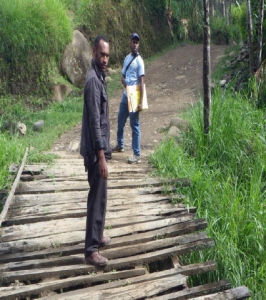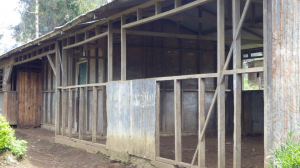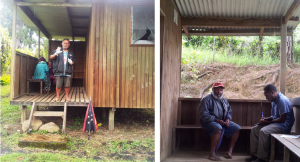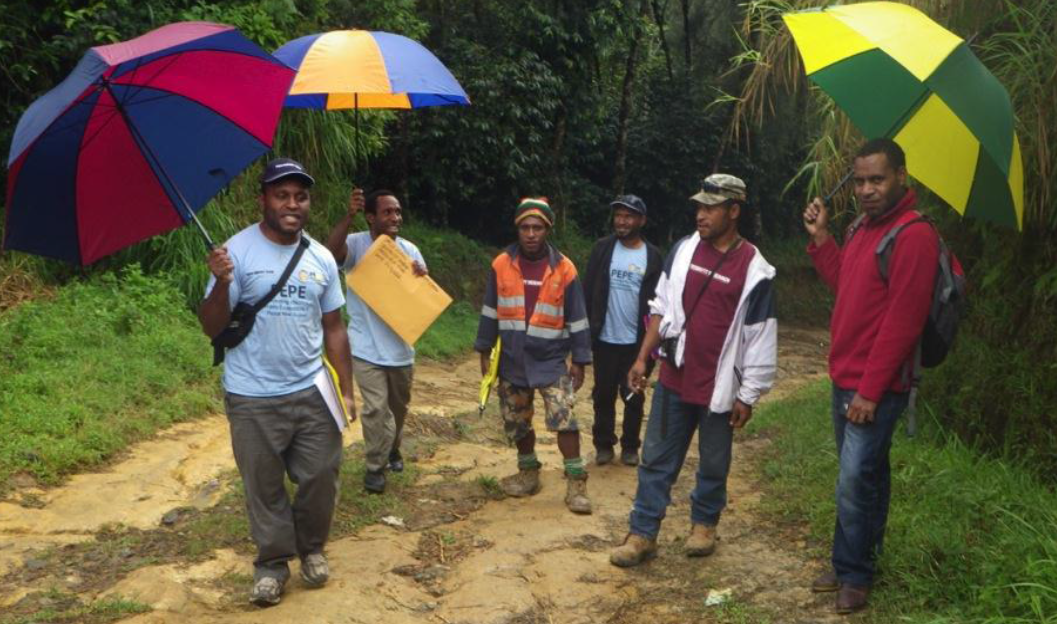In a recent post for this blog, Colin Wiltshire shared his experience of gathering data in the Gulf province of Papua New Guinea (PNG) for a major survey into public service delivery in PNG. The survey, completed in December 2012, is a key component of the Promoting Effective Public Expenditure (PEPE) in PNG project. The three-year project is being implemented collaboratively by the National Research Institute (NRI) of PNG and the ANU’s Development Policy Centre, and is financially supported by AusAID through the Economic and Public Sector Program.
Survey teams working for the project have covered some of the most remote parts of the country. I was part of a team of five that surveyed 30 primary schools and 19 health facilities in the Highlands province of Enga, one of two in that region to be covered. Enga is mostly rural and very remote, thanks to a difficult and mountainous terrain with high annual rainfall and poor infrastructure.
We conducted our survey in three districts (Wabag, Lagaip-Porgera and Wapenamanda) over two months. On our arrival in Enga, we visited the provincial administration building in Wabag, the provincial capital. We were surprised to find the provincial administrator’s office closed, although this explained why our phone calls had rung out and our faxes hadn’t transmitted when we’d tried to send notice a couple of weeks earlier about the upcoming survey.
 Grade 8 examinations were approaching so the survey team had to push ahead. We met with the provincial health and education directors who were very keen and supportive of the research in Enga province. However, to our dismay, the provincial education director informed us that all schools in Kandep (one of the districts originally in our survey) had been suspended due to election-related tribal fighting (see the photo on the right of the notice posted on the education director’s office door). So another district (Wapenamanda) was selected in its replacement and we randomly nominated the same number of facilities.
Grade 8 examinations were approaching so the survey team had to push ahead. We met with the provincial health and education directors who were very keen and supportive of the research in Enga province. However, to our dismay, the provincial education director informed us that all schools in Kandep (one of the districts originally in our survey) had been suspended due to election-related tribal fighting (see the photo on the right of the notice posted on the education director’s office door). So another district (Wapenamanda) was selected in its replacement and we randomly nominated the same number of facilities.
Most of the schools and health facilities we surveyed were quite remote, far from major towns and urban centres. It took hours of walking to reach them after driving on roads that were severely deteriorated due to lack of maintenance. Poor roads and bridges consistently made accessing remote facilities a challenge.
 For facilities in remote parts of the province, access to funds, including school subsidies, is difficult. For these schools and health facilities there are many obstacles to sourcing materials and basic infrastructure, even with an increased allocation of funds such as school fee subsidies. Apart from the time it would take to travel to the next town with banks and shops, it also takes time to access funds due to the strict procurement processes required, especially before funds are released.
For facilities in remote parts of the province, access to funds, including school subsidies, is difficult. For these schools and health facilities there are many obstacles to sourcing materials and basic infrastructure, even with an increased allocation of funds such as school fee subsidies. Apart from the time it would take to travel to the next town with banks and shops, it also takes time to access funds due to the strict procurement processes required, especially before funds are released.
We noticed that before schools could withdraw their school subsidies, the provincial education office had to verify and approve their current spending. This procurement requirement is commendable so far as it deters abuse of school funds, but it also has costs, such as the time taken by teachers to travel to the provincial education office to have their school expenditure approved.
In some schools, especially government-run schools, the communities often suspect that Head Teachers and BOM Chairpersons are colluding over the management of funds. This is largely because the Head Teachers and BOM Chairpersons are not really transparent in dealing with the financial matters of the schools. Also, the capacity to manage funds and keep adequate records is variable and wanting in most remote facilities. This inadequate financial capacity adds to community mistrust.
The level and frequency of contact or support from the district, provincial, and national government is also variable. Facilities in remote parts of the province had minimal to no visits and support in many years, including compulsory school and health inspections.
 Neglect in the maintenance of existing infrastructure is a major challenge for effective service delivery in Enga. First impressions of the entire survey revealed that this is common across all the provinces surveyed. The survey team surveyed a particular school in Wabag district which was about one hour walk from the main road, and one and half hours’ drive from the provincial capital. We crossed a river on foot-bridge to get to the school. The school was really rundown as most of the classrooms and teacher houses which were built in the 70s and 80s had never been
Neglect in the maintenance of existing infrastructure is a major challenge for effective service delivery in Enga. First impressions of the entire survey revealed that this is common across all the provinces surveyed. The survey team surveyed a particular school in Wabag district which was about one hour walk from the main road, and one and half hours’ drive from the provincial capital. We crossed a river on foot-bridge to get to the school. The school was really rundown as most of the classrooms and teacher houses which were built in the 70s and 80s had never been refurbished. Two of the houses for teachers and three classrooms had been built by the local community using funds raised by themselves through several fundraising activities. Some of these classrooms had large holes in the walls no desks, so students sat in the dirt. The only aid post in the village was shut down early last decade because it was so rundown due to lack of maintenance. There were only four teachers and a couple of volunteers from the community who were teaching the entire primary school – some of them teaching multi-grade classes.
 On our return after surveying the school, to our surprise a huge crowd (nearly the entire village) was waiting for us. Thinking that we were government officials or representatives from a donor agency, they started describing their development needs. They demanded that a road be built connecting their village to the main road, as well as new teacher housing and classrooms, a new aid post and that the village be given a water supply.
On our return after surveying the school, to our surprise a huge crowd (nearly the entire village) was waiting for us. Thinking that we were government officials or representatives from a donor agency, they started describing their development needs. They demanded that a road be built connecting their village to the main road, as well as new teacher housing and classrooms, a new aid post and that the village be given a water supply.
We tried to explain why we were there, but they repeated their demands for basic government services for nearly two hours. We learned later that they had not received any government officials on visits to their school or health facility, and had not seen any improvement in basic services for over 15 years. Luckily for us, it started to rain, and we took the opportunity to leave, literally running from the meeting place until we crossed the river and got to our vehicle.
The challenges involved in providing public services in Enga province are many and real, but there are also opportunities to improve public service delivery, especially in the remote areas of the province.
 The survey team met some very dedicated teachers and health workers, including volunteers, retired teachers and health workers, who continued to work under very trying conditions to ensure that facilities stayed open. Most of these officers take on extra responsibilities, such as teaching multi-grade classes. We met two retrenched health workers at two separate locations, who continue to work in their village aid posts, and carry out health patrols to other remote villages by walking hours with heavy bags and boxes of drugs and medical kits, even though they were no longer on the payroll. No health workers had been appointed in their place since they were retrenched early last decade.
The survey team met some very dedicated teachers and health workers, including volunteers, retired teachers and health workers, who continued to work under very trying conditions to ensure that facilities stayed open. Most of these officers take on extra responsibilities, such as teaching multi-grade classes. We met two retrenched health workers at two separate locations, who continue to work in their village aid posts, and carry out health patrols to other remote villages by walking hours with heavy bags and boxes of drugs and medical kits, even though they were no longer on the payroll. No health workers had been appointed in their place since they were retrenched early last decade.
Now that provinces, districts and local government have more funds, district officers, such as health and school inspectors, should be assisted with logistical support (such as vehicles and airfares) to carry out periodic school and health inspections at remote facilities. This would greatly boost the morale of the dedicated health workers and teachers in remote places.
 Communities are determined to see change. There is a need to engage with people who can bring it about. Involving local communities more deeply in development promotes ownership. It also provides a way for them to be a part of the solution by demanding accountability for public funds received and spent by schools.
Communities are determined to see change. There is a need to engage with people who can bring it about. Involving local communities more deeply in development promotes ownership. It also provides a way for them to be a part of the solution by demanding accountability for public funds received and spent by schools.
With more funds now at the lower levels of government, it is time to maintain the existing infrastructure. Roads and bridges in the districts need to be fixed immediately, as well as the classrooms, housing for teachers and health facilities that are vital to health and education services for rural communities.
Churches are also a vital part of service delivery. We found that where the government wasn’t present, the churches are, including in remote parts of the province. All survey teams reported that in the most rural and remote areas, churches have the greatest presence. With more funds now available, the churches must be more included in the development process.
These are only some first impressions having completed the survey. More in-depth analysis of the survey results is underway, and findings will be disseminated in due course, including at the next Budget Forum on 29 August 2013.
As for me, I will never forget my time in Enga in October and November 2012. I grew up in Enga, so going back there, and especially seeing remote areas I had never been to before, confirmed my view (expressed here) that the last decade has indeed been a lost one for development in Papua New Guinea. But seeing dedicated teachers and health workers, paid and unpaid, continue to provide services to their communities in the most difficult conditions was also inspirational. It taught me that we must not give up, and that things can get better.
Andrew Anton Mako is a research fellow at the National Research Institute. He was the research facilitator for the survey team that covered Enga province. Prior to that, he was a post-graduate student at Crawford School and a researcher at the Development Policy Centre.



Andrew Mako’s article truly reflects what is happening in the Enga Province, as well as other parts of Papua New Guinea. A similar perception I sometimes ask myself as an Engan. In a presentation by Deni ToKunai during the 2013 PNG Updates at the Crawford School of Public Policy, ANU he was making particular reference to the word ‘Action’ and he referred this word to the Enga Governor, Hon. Peter Ipatas as the Action Governor of Enga. There is no dispute on that word to the Governor in terms of implementing policies in relation to higher education. Mako’s research reveals the lack of fundamental educational policies and in the case of Enga’s Action Governor, priority is only given to the higher education and the lower primary, community and high schools are facing a great challenge. The ratio of student and teachers is unbalanced, there no class rooms, no educational materials and equipment, and there is no road network. A policy for linking higher and lower education in Enga is urgently needed here. The Enga Provincial Education Board and the Government needs strategic policies to bridge this gap. How can a Province preach about Human Capital Development in the province when the lower education level is getting bad to worst and they focus only on the higher education level? All in all, research needs to be done in this area to come up with strategic policies to bridge this missing linkage.
Bill,
Thanks for your comment. Our survey, which we completed late last year, had two important aims. One was to look back over the last ten years, where revenues have tripled, and see what impact this has had on service delivery. This sort of benchmarking is critical for every country. Going back to the same schools and health centres which were surveyed 10 years ago is a great opportunity to identify areas of progress and regress. The other aim of the survey was precisely to examine the impact of recent government reforms, such as the central government support in place of school fees. Is that support reaching schools, and how are they using it?
It would be a grave mistake to assume that DSIP and other forms of devolved funding will solve the problems of lack of maintenance and understaffing at the front line of service delivery. DSIP and similar funds are invariably spent on projects. This means new roads and new buildings, or perhaps rehabilitated roads and buildings. Even if these are useful investments, there is no guarantee that the roads will be maintained, or the new facilities staffed. Our analysis shows that recurrent funding is being squeezed at the expense of the huge boom in devolved development spending.
Finally, even if you think DSIP is the solution to PNG’s development problems, then you will be interested in our research, because our analysis of schools and health centres reveals a lot about how DSIP is being used. We found lots of unfinished DSIP projects, and also examples of projects which were completed but are not being utilized due to lack of staff.
If you’re interested, please check out the project website and especially the presentations made at the February budget forum. We plan to release the results of our analysis in the second half of the year.
You can also find a really good video of the budget forum which EMTV has just released here.
The infrastructure and maintenance situation across PNG has been well documented. The Team seem to be reinventing the wheel. The O’ Neill government has acknowledged the situation and funded districts to improve social and economic infrastructure, i.e. K10 mil for each of the 89 districts per annum under DSIP. The problem now to be addressed is capacity at the district level to use funds appropriately, i.e. limit corruption and use quality contractors. Moreover a complete revitalisation of the public service is necessary to provide effective service delivery. The recently announced Special Parliamentary Committee on Public Sector Reform and Service Delivery forms part of the Govt’s response to this problem. Hon. Bire Kimisopa MP is chairman of the Committee and has the support of the PM to radically overhaul the public service. I consider this a case of research lagging behind Govt intervention.